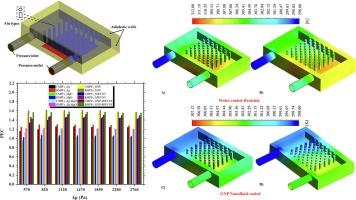用于电子设备冷却的单一和混合纳米流体冷却微翅片散热器的数值分析(第二部分)
IF 5.1
3区 工程技术
Q2 ENERGY & FUELS
引用次数: 0
摘要
本研究调查了使用单一和混合纳米流体的圆形和矩形配置微型针形鳍片散热器的热性能和液压性能。由于高性能电子设备需要高效的冷却解决方案,这项研究探索了纳米流体中金属氧化物(Ag、MgO)和碳基纳米颗粒(GNP、MWCNT)的新型组合。微针鳍和纳米粒子的体积分数保持恒定,以评估它们对热液压性能的影响。该方法包括用含水纳米流体作为冷却剂进行实验,测量入口和出口处的压降(Δp)。使用热阻 (Rth)、努塞尔特数 (Nuavg)、泵功率 (PP)、容积流量 (Q)、总体性能 (OP) 和性能评估标准 (PEC) 等指标对热性能进行评估。结果表明,与传统水冷相比,基于 GNP 的单纳米流体可显著降低矩形散热器的 Rth 46.41%,Nuavg 提高 60.54%,PEC 提高 62%。矩形和圆形配置之间的比较显示,Rth 的差异最小,分别为 2.54% 和 3.57%。GNP 分散纳米流体的性能优于其他冷却剂,在 Δp = 820 Pa 条件下,矩形配置的 PEC 为 1.62,而圆形配置为 1.52。结论表明,使用基于 GNP 的纳米流体的矩形针形鳍片具有更优越的热液压性能。本研究的主要成果对提高先进电子系统的冷却效率具有重要贡献。本文章由计算机程序翻译,如有差异,请以英文原文为准。

Numerical analysis of mono and hybrid nanofluids-cooled micro finned heat sink for electronics cooling-(Part-II)
This study investigates the thermal and hydraulic performance of heat sinks with micro pin-fins in circular and rectangular configurations using mono and hybrid nanofluids. Motivated by the need for efficient cooling solutions in high-performance electronic devices, the research explores novel combinations of metallic oxide (Ag, MgO) and carbon-based nanoparticles (GNP, MWCNT) in nanofluids. A constant volume fraction of micro pin-fins and nanoparticles was maintained to assess their effects on thermohydraulic performance. The method involved experiments with aqueous nanofluids as coolants, measuring pressure drops () at the inlet and outlet. Thermal performance was evaluated using metrics like thermal resistance (), Nusselt number (), pumping power (), volumetric flow rate (), overall performance (), and performance evaluation criterion (). Results showed that GNP-based mono nanofluids significantly reduced by 46.41% and increased by 60.54% and PEC by 62% in rectangular heat sinks compared to conventional water cooling. Comparisons between rectangular and circular configurations revealed minimal differences of 2.54% and 3.57%. GNP-dispersed nanofluids outperformed other coolants, with the rectangular configuration achieving a higher of 1.62 versus 1.52 for the circular configuration at Δp = 820 Pa. The conclusions suggest that rectangular pin-fins with GNP-based nanofluids offer superior thermohydraulic performance. The key outcomes from current study have significant contribution in enhancing the cooling efficiency of advanced electronic systems.
求助全文
通过发布文献求助,成功后即可免费获取论文全文。
去求助
来源期刊

Thermal Science and Engineering Progress
Chemical Engineering-Fluid Flow and Transfer Processes
CiteScore
7.20
自引率
10.40%
发文量
327
审稿时长
41 days
期刊介绍:
Thermal Science and Engineering Progress (TSEP) publishes original, high-quality research articles that span activities ranging from fundamental scientific research and discussion of the more controversial thermodynamic theories, to developments in thermal engineering that are in many instances examples of the way scientists and engineers are addressing the challenges facing a growing population – smart cities and global warming – maximising thermodynamic efficiencies and minimising all heat losses. It is intended that these will be of current relevance and interest to industry, academia and other practitioners. It is evident that many specialised journals in thermal and, to some extent, in fluid disciplines tend to focus on topics that can be classified as fundamental in nature, or are ‘applied’ and near-market. Thermal Science and Engineering Progress will bridge the gap between these two areas, allowing authors to make an easy choice, should they or a journal editor feel that their papers are ‘out of scope’ when considering other journals. The range of topics covered by Thermal Science and Engineering Progress addresses the rapid rate of development being made in thermal transfer processes as they affect traditional fields, and important growth in the topical research areas of aerospace, thermal biological and medical systems, electronics and nano-technologies, renewable energy systems, food production (including agriculture), and the need to minimise man-made thermal impacts on climate change. Review articles on appropriate topics for TSEP are encouraged, although until TSEP is fully established, these will be limited in number. Before submitting such articles, please contact one of the Editors, or a member of the Editorial Advisory Board with an outline of your proposal and your expertise in the area of your review.
 求助内容:
求助内容: 应助结果提醒方式:
应助结果提醒方式:


